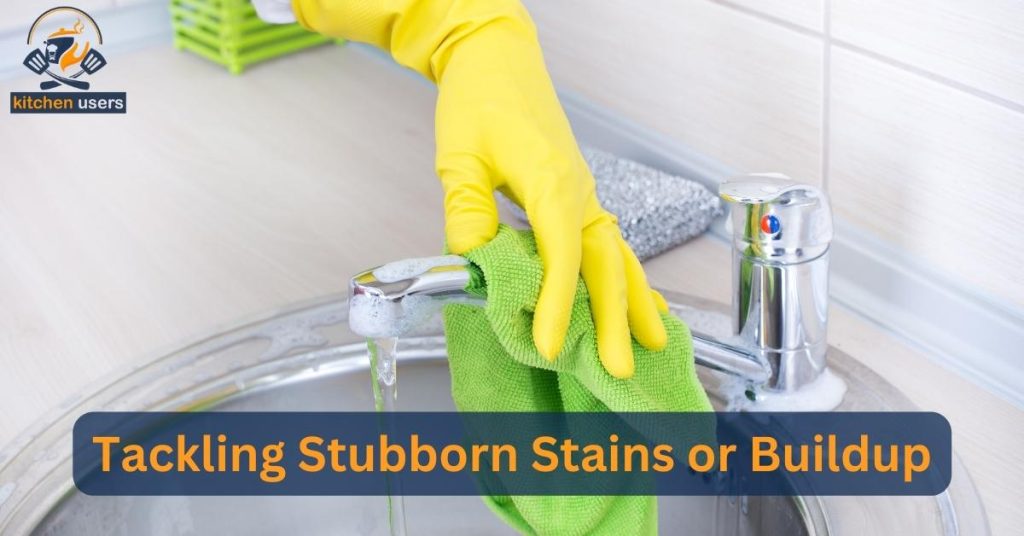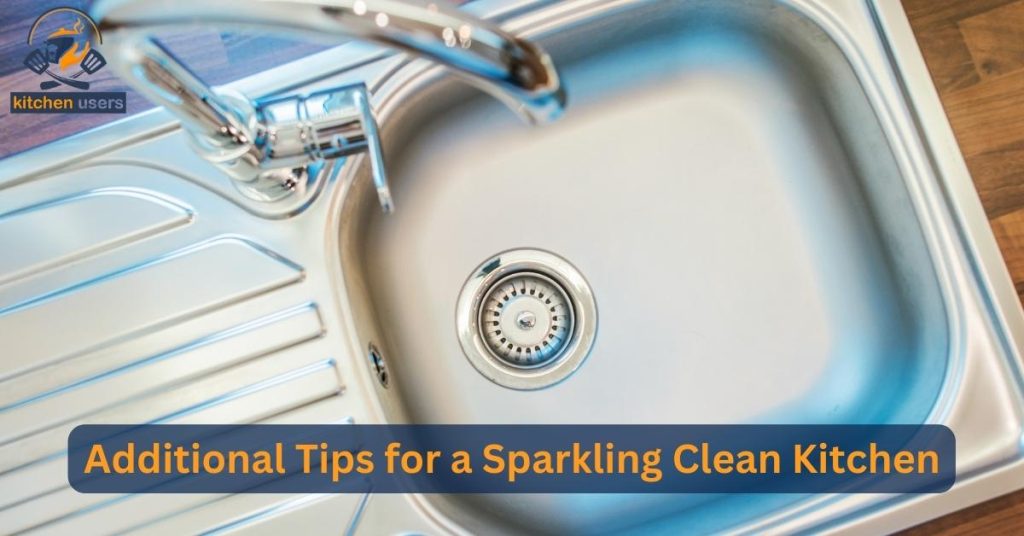If you have ever felt overwhelmed and frustrated while trying to keep your kitchen sink sparkly clean, you’re not alone. Keeping your Cleaning Kitchen Sinks And Faucets sparkling can be a tough chore for busy home cooks but don’t fret. The right tools and techniques will help make this task much more manageable!
In this blog post, we’ll share some expert tips on how to give your kitchen sink and faucets. Also, saving you time and energy on a more thorough clean path than before.
So if you’ve been putting off deep-cleaning your kitchen sink, now is the perfect time to start! Read on for our top tips on cleaning sinks and faucets.
Why Is It Important To Clean Your Kitchen Sink And Faucet?

Your kitchen sink and faucet are two of the most used surfaces in your home, and they can also be two of the dirtiest. That’s because they come into contact with food, water, and other materials that can harbor bacteria.
Here are some reasons why it’s important to clean your kitchen sink and faucet:
To prevent the spread of germs
Bacteria can spread from your sink and faucet to your hands, food, and other surfaces. It can lead to food poisoning, illness, and other health problems.
To keep your sink looking its best
A dirty sink can make your kitchen look cluttered and unsanitary. By cleaning your sink, you can keep it looking its best and make your kitchen more pleasant.
To extend the life of your sink and faucet
Over time, dirt and grime can build up on your sink and faucet, damaging the finish and making them harder to clean. By cleaning your sink and faucet, you can help to extend their lifespan.
How To Clean Kitchen Sinks And Faucets [ Best Tips For You Step-By-Step 2023]

Cleaning a kitchen sink and faucet is vital to maintaining a healthy kitchen. Follow these step-by-step tips to achieve a sparkling and germ-free sink and faucet:
Cleaning Kitchen Sinks And Faucets for Materials
To clean your kitchen sinks and faucets, you will need the following tools and supplies:
Baking soda:
This versatile cleaning agent helps remove stains and deodorizes your sink and faucet.
White vinegar:
Vinegar is excellent for tackling mineral deposits and hard water stains on your fixtures.
Dish soap:
Mild dish soap is perfect for cutting through grease and grime on your sink and faucet surfaces.
Soft cloth:
A soft cloth is gentle on your fixtures while wiping away dirt and residue.
Toothbrush:
A toothbrush with soft bristles is ideal for cleaning hard-to-reach areas and crevices around your faucet.
Spray bottle:
Fill a spray bottle with water and white vinegar or a cleaning solution. It will make it easier to apply the cleaning solution.
Preparing for Cleaning

To clean your kitchen sinks and faucets, it’s essential to prepare beforehand. Follow these simple steps to get ready:
Gather Necessary Supplies:
Before you begin, collect the cleaning supplies you’ll need. It may include baking soda, vinegar, dish soap, a soft cloth, a toothbrush, and a spray bottle. Having these supplies available will make the cleaning process more convenient.
Remove Any Dishes or Debris from the Sink:
Clear out any dishes, juicer, blender, utensils, or debris from the sink. It will ensure that you have a clean and clutter-free surface to work with.
Clear the Area Around the Faucet:
Remove any items or objects near the faucet that might obstruct your cleaning efforts. Clearing the area will allow you to access all parts of the faucet and clean it.
Cleaning the Sink
To achieve a clean and sparkling sink, follow these steps:
Using a Mild Detergent or Dish Soap:
Apply a small amount of mild detergent or dish soap to a sponge or brush. It will help break down grease and grime on the sink’s surface.
Scrubbing the Sink with a Sponge or Brush:
Scrub the sink using a sponge or brush, working in circular motions. Pay careful attention to regions prone to accumulation, such as;
- Around the drain and
- The edges of the sink.
Paying Attention to Corners and Crevices:
Use the sponge or brush to clean hard-to-reach corners and crevices. These areas can accumulate dirt and need extra attention for a thorough cleaning.
Rinsing the Sink:
After scrubbing, rinse the sink with warm water. Ensure all soap residue wash away to leave a clean and residue-free surface.
Cleaning the Faucet
Here are some tips for cleaning your faucet:
Removing Mineral Deposits with Vinegar or Lemon Juice:
You can use vinegar or lemon juice to get rid of mineral deposits on your faucet. Apply the vinegar or lemon juice to a soft cloth and scrub the affected areas. Rinse afterward.
Using a Toothbrush or Soft Cloth to Clean Hard-to-Reach Areas:
Use a toothbrush or a soft cloth to clean the hard-to-reach areas of your faucet, such as;
- The crevices and
- Joints.
Scrub to remove any dirt or grime.
Polishing the Faucet with a Microfiber Cloth:
After cleaning, give your faucet an excellent polish using a microfiber cloth. It will help remove water spots or streaks, leaving your faucet shiny and clean.
Tackling Stubborn Stains or Buildup

Sometimes, kitchen sinks and faucets can develop stubborn stains or buildup. Here are some tips to help you tackle them:
Dealing with Rust Stains:
If you notice rust stains on your sink or faucet, you have a few options:
- Try using a mild acidic cleaner.
- Create a paste using baking soda and water. Apply the cleaner or paste to the affected areas, and let it rest for a few minutes before scrubbing it with a brush or sponge. Rinse afterward.
Removing Limescale or Hard Water Deposits:
To tackle limescale or hard water deposits:
- Mix equal parts water and white vinegar.
- Apply the solution to the affected areas, allowing it to sit for a while to dissolve the deposits.
- Scrub the area and rinse.
Using Baking Soda and Vinegar for Tough Stains:
For stubborn stains, you can use a powerful combination of baking soda and vinegar:
- Sprinkle baking soda over the stained area.
- Spray or pour vinegar onto the baking soda.
- Allow the mixture to bubble and fizz for a few minutes, breaking down the stain.
- Scrub the area and rinse.
Preventive Measures
Here are some preventive measures you can take to keep your kitchen sink and faucets clean:
Regular maintenance and cleaning schedule:
The best way to prevent dirt and grime is to clean your sink and faucets. Once a week is a good goal, but if you use your sink often, you may need to clean it more often.
Using a Sink Strainer to Prevent Clogs:
Place a sink strainer over the drain to catch food particles and other debris. This simple tool can help prevent clogs and keep your sink draining. Empty the filter and clean it to maintain its effectiveness.
Avoiding abrasive cleaners or scrubbers:
Abrasive cleaners or scrubbers can damage the finish on your sink and faucet. Use a nonabrasive cleaning or a gentle water and soap solution.
Maintenance Tips for Different Types of Sinks and Faucets
Here are some maintenance tips for different types of sinks and faucets:
Stainless Steel Sinks:
- Wipe the stainless steel sink with a damp cloth after each use.
- Use a mild soap and water solution or a stainless steel cleaner for stubborn dirt or grime.
- Dry the sink after cleaning to prevent water spots.
Porcelain Sinks:
- Clean porcelain sinks with a soft cloth, mild soap, and water solution.
- Avoid using abrasive materials to prevent scratches.
- Dry the sink after cleaning to maintain its shine.
Composite Sinks:
- Wipe down the composite sink with a damp cloth after each use.
- Use a mild soap and water solution or a composite cleaner for tougher stains.
- Dry the sink to prevent water spots and maintain its appearance.
Chrome Faucets:
- Wipe the chrome faucet with a damp cloth after each use.
- Use mild water and soap solutions or a chrome cleaning solution.
- Dry the faucet to prevent water spots and maintain its shine.
Brushed Nickel Faucets:
- Clean brushed nickel faucets with a soft cloth, mild soap, and water solution.
- Avoid using abrasive materials to prevent scratches on the brushed nickel surface
- Dry the faucet after cleaning to maintain its brushed appearance.
Additional Tips for a Sparkling Clean Kitchen

Here are some more tips to keep your kitchen sparkling clean:
Cleaning the Surrounding Countertops and Backsplash:
- Use a gentle detergent to clean the work surfaces and backsplash or a mixture of water and vinegar.
- Remove any spills or stains to prevent them from setting in.
- Clean with a soft scrub brush or sponge grout lines if necessary.
Keeping the Garbage Disposal Fresh:
- Run cold water and grind a few ice cubes to keep the garbage disposal smelling fresh.
- You can also add a slice of lemon or some baking soda to neutralize odors.
- Avoid disposing of greasy or fibrous foods that can cause clogs or unpleasant smells.
Maintaining a Clean and Organized Kitchen:
- Develop a cleaning routine and stick to it. Clean and put away dishes, utensils, and other kitchen items.
- Sweep or vacuum the kitchen floor daily to remove dirt and debris.
- Keep cleaning supplies handy and accessible to encourage regular maintenance.
FAQs
Here are some FAQs about cleaning kitchen sinks and faucets:
1. How To Deep Clean Kitchen Sink Drain Naturally?
Here is a natural way to deep clean your kitchen sink drain:
- Pour 1/2 cup of baking soda down the drain.
- Pour 1/2 cup of vinegar down the drain.
- Let the mixture sit for 30 minutes.
- Pour a pot of boiling water down the drain.
- Repeat steps 1-4 if necessary.
2. How Often Should I Clean My Kitchen Sink And Faucet?
Clean your kitchen sink and faucet at least once weekly. If you use your sink, you may need to clean it more often.
3. How Can I Remove Stubborn Hard Water Stains?
Here are some tips on how to remove stubborn hard water stains from your kitchen sink:
- Make a vinegar-and-water solution. Mix equal parts vinegar and water in a spray bottle. Spray the solution onto the stains and let it sit for 30 minutes. Then, scrub the colors with a sponge or brush. Rinse the area with clean water.
- Use a commercial hard water stain remover. Follow the directions on the product label.
4. Should I Clean My Sink With Bleach Or Vinegar?
It is generally safer to clean your sink with vinegar rather than bleach. Bleach can be harsh and may damage certain sink materials. Vinegar is a natural and effective cleaner that can aid in the get rid of stains and killing germs.
5. What Is The Most Effective Way To Clean A Kitchen Sink?
A mild soap and water solution is the most effective way to clean a kitchen sink. You can also use a commercial kitchen sink cleaner. Follow the guidelines on the product label.
Conclusion of cleaning kitchen sinks and faucets
Keeping your cleaning kitchen sinks and faucets is essential for a hygienic and safe kitchen. By following these tips, you can maintain a sparkling sink and taps. Regular cleaning and addressing tough stains are necessary for a new look.
Remember to consider the specific care needs of different sink and faucet materials. Using a sink strainer and avoiding harsh cleaners will help prevent clogs and damage.
Incorporate these tips into your routine for clean and inviting kitchen things. Enjoy a fresh space that enhances your cooking experience.
As a 10 years veteran in the culinary industry, I have developed a passion for all things kitchen. With a deep understanding of food preparation and cooking techniques, I am a true kitchen specialist. My experience working in Khedmot kitchen has allowed me to hone my skills and become an expert in creating delicious and visually appealing dishes.
I am a creative and innovative chef, constantly experimenting with new ingredients and cooking methods to bring unique and memorable dining experiences to my customers. In addition to my culinary expertise, I am also highly organized and able to effectively manage a team of kitchen staff, ensuring that all tasks are completed efficiently and to a high standard.
I am dedicated to my craft and always strive to create exceptional dining experiences for my customers. Whether it’s developing a new menu, training my kitchen team, or working with local suppliers, I am always looking for ways to improve and take my kitchen to the next level.
If you’re looking for a skilled and passionate kitchen specialist, look no further. I am eager to bring my expertise to your team and help take your kitchen to the next level.


